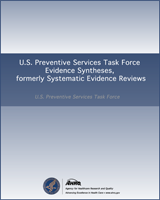NCBI Bookshelf. A service of the National Library of Medicine, National Institutes of Health.
Structured Abstract
Background:
Menopausal hormone therapy to prevent chronic conditions, such as cardiovascular disease and cancer, is currently not recommended because of its adverse effects.
Purpose:
To update evidence on the effectiveness of hormone therapy in reducing risks for chronic conditions, its adverse effects, and differences among population subgroups for the U.S. Preventive Services Task Force.
Data Sources:
We searched MEDLINE (January 2002 to November 30, 2011), Cochrane Central Register of Controlled Trials and Cochrane Database of Systematic Reviews (through third quarter 2011), Scopus, and reference lists.
Study Selection:
We included English-language, randomized, placebo-controlled trials that evaluated the prevention of new conditions rather than treatment of existing conditions and reported health outcomes.
Data Extraction:
We abstracted details about participants, study design, analysis, followup, and results; study quality was rated using established criteria.
Data Synthesis:
Nine fair-quality trials provided data for outcomes. The Women’s Health Initiative (WHI) reported most of the results, had 11 years of followup, and was most applicable to the target population. Participants in the WHI estrogen only trial had more risk factors for cardiovascular disease and fewer for breast cancer than those in the estrogen plus progestin trial. In WHI, compared with placebo, estrogen plus progestin reduced fractures (46/10,000 women-years) and increased invasive breast cancer (8/10,000), stroke (9/10,000), deep vein thrombosis (12/10,000), pulmonary embolus (9/10,000), lung cancer death (5/10,000), gallbladder disease (20/10,000), dementia (22/10,000), and urinary incontinence (872/10,000). Estrogen only reduced fractures (56/10,000) and invasive breast cancer incidence (8/10,000) and death (2/10,000), and increased stroke (11/10,000), deep vein thrombosis (7/10,000), gallbladder disease (33/10,000), and urinary incontinence (1271/10,000). Among subgroup analyses, there were no consistent differences by age and comorbidities.
Limitations:
Few trials or subgroup analyses were powered for prevention outcomes; 40 to 50 percent of WHI participants discontinued their medications by the end of the trial.
Conclusions:
Both hormone therapy regimens decreased fractures but increased stroke, thromboembolic events, gallbladder disease, and urinary incontinence. Estrogen plus progestin increased breast cancer and probable dementia, while estrogen alone decreased breast cancer.
Acknowledgements: The authors acknowledge Andrew Hamilton, MLS, MS, for assistance with literature searches, Rochelle (Rongwei) Fu, PhD, for statistical assistance, and Amanda Brunton, BS, for assistance with preparing this draft report; all are based at Oregon Health & Science University. We also thank AHRQ Officers Jennifer Croswell, MD, MPH, and Tess Miller, DrPH; USPSTF leads Kirsten Bibbins-Domingo, PhD, MD, Carolina Reyes, MD, and Sandy Schwartz, MD; and Mary Barton, MD, MPP, for their contributions to this report.
Prepared for: Agency for Healthcare Research and Quality, U.S. Department of Health and Human Services1, Contract No. HHSA-290-2007-10057-I-EPC3, Task Order No. 3, Prepared by: Oregon Evidence-based Practice Center2, Oregon Health & Science University,
Suggested citation:
Nelson HD, Walker M, Zakher B, Mitchell J. Menopausal Hormone Therapy for the Primary Prevention of Chronic Conditions: Systematic Review to Update the 2002 and 2005 U.S. Preventive Services Task Force Recommendations. Evidence Synthesis No. 93. AHRQ Pub No. 12-05168-EF-1. Rockville, MD: Agency for Healthcare Research and Quality; May 2012.
This report is based on research conducted by the Oregon Evidence-based Practice Center (EPC) under contract to the Agency for Healthcare Research and Quality (AHRQ), Rockville, MD (Contract No. 290-02-0024). The investigators involved have declared no conflicts of interest with objectively conducting this research. The findings and conclusions in this document are those of the author(s), who are responsible for its content, and do not necessarily represent the views of AHRQ. No statement in this report should be construed as an official position of AHRQ or of the U.S. Department of Health and Human Services.
The information in this report is intended to help clinicians, employers, policymakers, and others make informed decisions about the provision of health care services. This report is intended as a reference and not as a substitute for clinical judgment.
The final report may be used, in whole or in part, as the basis for the development of clinical practice guidelines and other quality enhancement tools, or as a basis for reimbursement and coverage policies. AHRQ or U.S. Department of Health and Human Services endorsement of such derivative products may not be stated or implied.
- 1
540 Gaither Road, Rockville, MD 20850; www
.ahrq.gov - 2
3181 SW Sam Jackson Parkway, Portland, OR 97239; www
.ohsu.edu/epc
